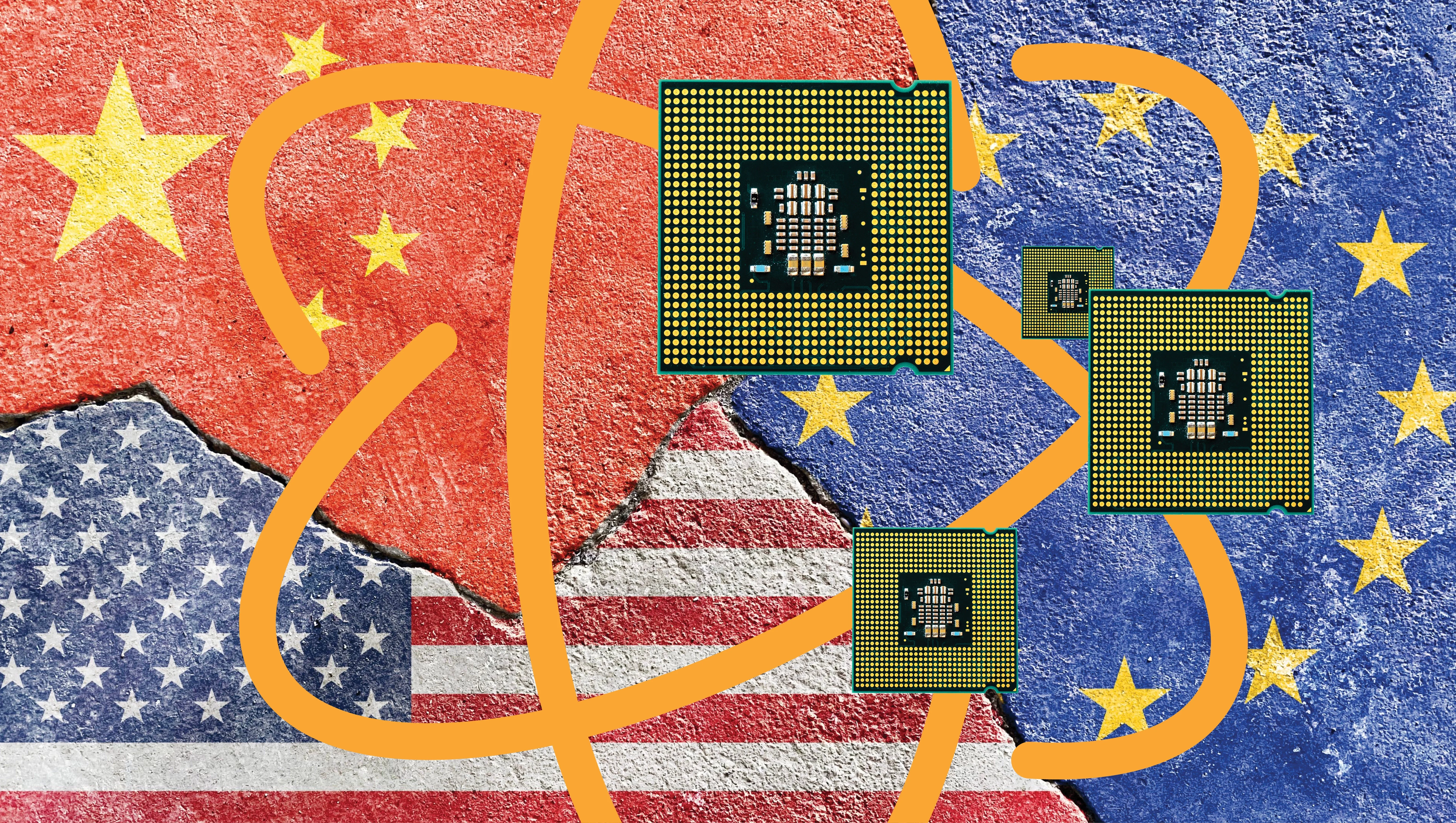Cutting-edge science and technology are amongst the most prominent of these critical sectors and have become a theatre of intense competition. Take AI: recent debates around it have been dominated by geopolitical considerations, with great powers racing to reach artificial general intelligence (AGI) before their rivals. To do so, the US restricted American firms’ ability to sell advanced semiconductors to China, for example. China has threatened to suspend rare-earth exports necessary for critical hardware components to the US.
Where traditional power was measured in terms of territory, military might or economic output, the ability to shape, control and deploy advanced technologies now determines the contours of global influence. This shift is visible in the way states and other actors increasingly treat scientific knowledge, technological infrastructure and the flow of expertise as strategic assets to be guarded, leveraged or denied. In the Cold War era scientific fragmentation was constrained to areas with direct military application, and broad international collaboration remained. Now, however, the domains that are considered strategic have expanded into general fields such as AI and biotechnology.
Another important difference to the Cold War era is today’s unprecedented level of global economic interdependence. Global supply chains have become intricate international networks that connect manufacturers, suppliers, logistics providers and consumers across continents to produce and deliver goods or services. The COVID-19 pandemic and more recently the Russia-Ukraine war have shown how disruptions in one part of the world — such as a shortage of personal protective equipment from China or natural gas from Russia — impact industries and economies worldwide.
These interdependencies create choke points that are being weaponised. In the context of science and technology, a choke point is a critical node — a material, process or platform — that is essential for the functioning of a broader system. Control over such a node allows an actor to exert significant influence, either by enabling their own progress or by constraining the capabilities of others. The appeal of focusing on choke points lies in their efficiency: rather than attempting to dominate entire technological ecosystems, actors can target specific vulnerabilities that ripple outward.
The global semiconductor supply chain, for example, has become a focal point for such strategies, as access to cutting-edge chips is indispensable for a range of emerging technologies. Similarly, the ability to set technical standards, regulate key software platforms or control access to specialised scientific equipment can translate into significant leverage. For example, the European Union’s GDPR not only governs digital privacy within Europe but has become the de facto global privacy standard, as international businesses must comply to operate in the EU (this outsized influence is sometime referred to as the “Brussels effect”). In terms of equipment, the Dutch company ASML is the sole supplier of the extreme-ultraviolet (EUV) lithography machines required to manufacture the most advanced microchips.
This approach is not limited to hardware. Increasingly it extends to intangible domains such as data and talent, which have become the lifeblood of scientific and technological advancement.
Data, in particular, has assumed a central role in the geopolitics of the 21st century. The ability to collect, store and analyse vast quantities of information underpins progress in AI, biotechnology and other fields. As a result, control over data pipelines — and thus who can access, process and benefit from data — has become a matter of national and economic security. States and corporations are investing in data infrastructure, erecting regulatory barriers to cross-border data flows and treating data as a strategic asset. The contest over data sovereignty is reshaping international relations, as countries seek to balance the benefits of open science with the imperatives of privacy, security and competitiveness.
The competition for talent is equally important. Scientific and technological progress depends not only on physical resources or infrastructure, but on the cultivation and attraction of the skilled researchers, engineers and innovators whose expertise animates the entire system. The global circulation of talent is both an opportunity and a vulnerability: attracting leading minds can accelerate national progress, while losing them can undermine long-term competitiveness, since the tacit knowledge embedded in professional networks and collaborative research is difficult to replicate or replace. As a result, restrictions on academic exchanges, tighter visa regimes and concerns about “brain drain” have become prominent features of the geopolitical landscape.
With science and technology becoming a new axis along which geopolitical power is exercised, the global research ecosystem is undergoing fragmentation. Where international collaboration once drove scientific progress, suspicion and strategic competition now threaten to silo knowledge and capacity. Export controls, national security reviews and regulatory barriers have made cross-border partnerships more difficult, particularly in sensitive domains like AI, quantum computing, and biotechnology. The result is a world in which scientific knowledge and technological capacity are increasingly compartmentalised, with actors seeking to secure their own advantages while guarding against the risks of dependence on others.
This fragmentation is further complicated by the layered nature of technological systems. Technologies rarely exist in isolation; they form complex “stacks” of mutually reinforcing capabilities. This means that while some actors may focus on controlling specific choke points, others invest in building broad, resilient technological bases that can provide alternative pathways around bottlenecks. For example, faced with the above-mentioned export bans and bottlenecks in chip fabrication, China has launched programmes spanning research, education, subsidies and domestic procurement, aiming to build an independent, end-to-end chip ecosystem — seeking to develop homegrown, redundant and diverse sources across the full supply chain.
Others are following suit in attempting to bypass bottlenecks. For example, Brazil, which holds the world’s second-largest rare-earth reserves, is rapidly developing 27 rare-earth projects to establish an independent supply chain of these materials, which are essential for high-tech. India, meanwhile, has launched the $10 billion Semicon India programme, offering major subsidies to attract both domestic and global semiconductor companies. The interplay between these strategies creates a dynamic landscape in which vulnerabilities and opportunities are constantly shifting.
Looking ahead, the role of science and technology as a factor in geopolitics will probably grow more pronounced. The search for new chokepoints will continue as technology evolves, as will efforts to build resilience through diversification, redundancy and the cultivation of domestic talent and data ecosystems.
Governance in this new era presents formidable challenges. Traditional, top-down approaches may struggle to keep pace with the rapid, decentralised and often unpredictable nature of technological change. More adaptive and experimental forms of governance will be needed — ones that can respond quickly to emerging vulnerabilities, recalibrate strategies in real time and foster the kind of innovation essential for resilience.
Ultimately, control over science and technology has become a decisive factor in geopolitics, one that is closely intertwined with a broader struggle for dominance. Success in this environment will depend not only on the ability to identify and exploit chokepoints, but perhaps more importantly on the capacity to adapt, innovate and collaborate in the face of constant change: the (ab)use of chokepoints will continue strengthening incentives for states and companies alike to find alternative economic and technological ecosystems. Substantial effort will probably go into mapping and shedding light on the economic networks binding the world together, probing for potential vulnerabilities, and assessing how best they could be mitigated. Those who can secure the flow of data, attract and retain talent, and build flexible, resilient technological systems will be best positioned to shape the future of the international order.
*Henry Farrel, SNF Agora Professor of International Affairs at Johns Hopkins School of Advanced International Studies in Baltimore, Maryland
*Kyle Chan, Postdoctoral Research Associate and Lecturer in Sociology at Princeton University, New Jersey * Federica Du Pasquier, Lecturer on Law and Global Affairs at Yale University in New Haven, Connecticut





